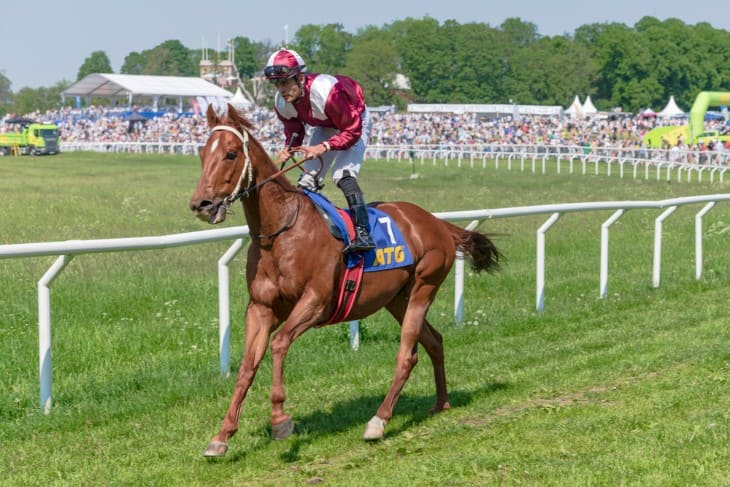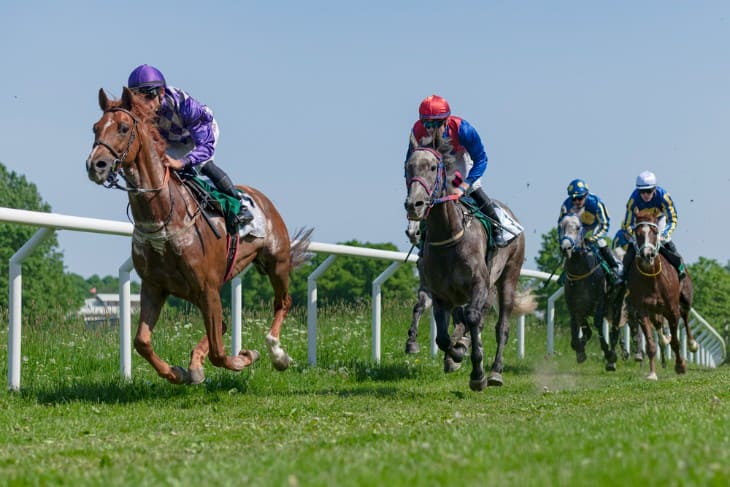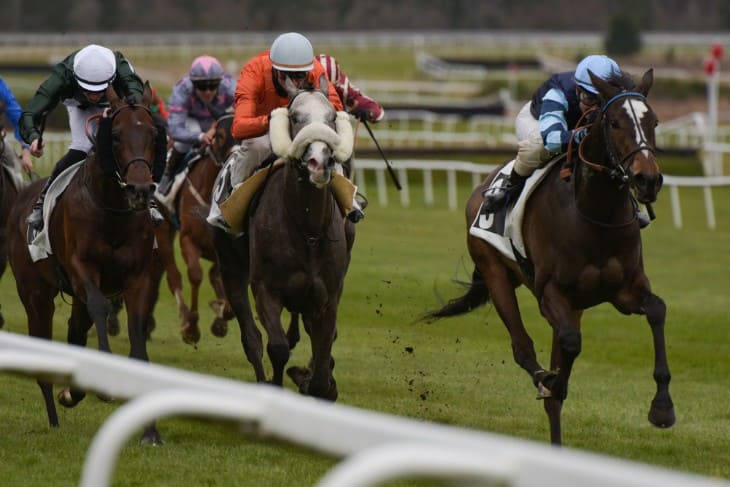- Stage Star
- Significant Races in Which Stage Star Competed over the Last Two Years
- Training Routines
- Stage Star's Performance in Major Competitions
- Dietary Regimen for Optimal Equine Health
- The Role of Genetics in Stage Star's Success
- Stage Star's Interaction with Trainers and Jockeys
- Horse Racing's Culture and The Influence of Stage Star
- Stage Stars 2024 Plan
- Stage Star at Cheltenham Festival 2024: A Thorough Day at the Races
- Comparisons with Well-Known Racehorses
- Takeaway
Stage Star
Stage Star, the well-known figure in horse racing, has descended from a prestige line known to produce champion racehorses—this combination of speed and stamina results from several generations of selective breeding. Stage Star's background refers to some of the most famous horses to ever set foot on a track, such as numerous Derby and St Leger winners. All these are evidence of great genetics and an indication that breeders have maintained those valuable bloodlines for many years.
This paper will focus on understanding Stage Star's lineage by looking at its notable ancestors and what traits they passed down. Important ancestors consisted of European and American thoroughbreds, which gave rise to a mix of agility, speed, and endurance. Stage Star's physical attributes and racing style show signs of his ancestors' influence, making a solid case for why heritage matters in equine sports.
Significant Races in Which Stage Star Competed over the Last Two Years
For instance, Stage Star had a good outing at various races across different locations within this period. One critical historical event for this horse happened on 16th March 2023 during the Cheltenham festival. During this particular occasion, H Cobden rode Stage Star to a vital win where he emerged as a top performer at Turners Novices' Chase- Grade 1 race. Therefore, this was not just about the ability shown by the stage star, but it also marked a significant achievement in its racing career. At Cheltenham, stage star underscored its abilities, making it one memorable performance in unison with jockey H Cobden.
Over time, punters have consistently seen dividends when backing Stage Star because they get value for their investment choices. This shows how reliable and consistent Stage Star is among its competitors in the competitive horse racing field.
Training Routines
It is worth noting that training routines determine the rate of success Stage Star is likely to achieve in the racing field. These routines are carefully designed to maximise physical output while minimising injury risks. The training program includes:
- Morning Exercise: Stage Star often starts its day with a morning workout, which usually involves a combination of slow trotting and faster gallops. Such exercises help build stamina and tone muscles.
- Track Work: Regular track work helps familiarise with racing conditions. This includes sprinting drills that enhance speed and agility.
- Swimming: Swimming sessions are also included for low-impact cardiovascular work, which helps build endurance without overtaxing the joints.
- Rest Days: Just as important as days dedicated to training, scheduled rest days allow time for muscle recovery and prevent burnout.
Mental conditioning is essential in addition to physical training. As such, it goes through various practice races that simulate race day scenarios regarding different track types, noise levels, etc., to train the mind accordingly. All these strategies combined led to his outstanding performance on the race tracks.
Stage Star's Performance in Major Competitions
Stage Star's performance in major competitions has been nothing short of remarkable, establishing its position as a formidable force in the racing world. Career highlights include victories in prestigious races such as the Epsom Derby and the Cheltenham Gold Cup. These wins reflect not just Stage Star's physical abilities but also show the planning and development of the training team. Each race exhibited Stage Star's adaptability and flexibility to tracks with different conditions and levels of competition.
These victories have implications beyond personal achievement. The horse's success has significantly made horse racing events popular and exciting. This particular horse's ability to consistently perform at high levels during major races has seen an increase in audience numbers, including younger people and international spectators. This influence highlights how exceptional equine athletes shape society's perception of future horse racing.
Dietary Regimen for Optimal Equine Health
One crucial aspect of the care of Stage Star involves laying out a well-thought-out dietary regimen that will promote health status and peak performances on stage or track field. Some key elements are:
- High-Quality Forage: Stage Star is basing her diet on quality forage that provides important fibres and other nutrients her body needs, like hay mixed with grass, designed to take care of her digestion systems while providing enough energy horses need.
- Concentrated Feed: Aside from forage, Stage Star receives concentrated feed to meet higher energy demands, such as oatmeal and barley-rich grains, which supply the energy required while undertaking various practices or participating in races.
- Supplements: Nutritional supplements play a vital role in Stage Star's diet. These supplements aim to support joint health, muscle recovery, and overall health; hence, they comprise vitamins, minerals, omega-3 fatty acids, etc.
- Hydration: Proper hydration is critical, especially during training sessions or contests; hence, this thoroughbred's hydration schedule includes clean water with electrolyte supplements to maintain hydration and prevent fatigue.
This nutritional program is closely monitored and adjusted as necessary, considering Stage Star's training schedule, racing calendar, and any health issues that may arise. The precision and attention to detail in Stage Star's diet mirror the all-encompassing approach towards horse care, ensuring that the horse does not lose shape throughout the season for racing purposes.

The Role of Genetics in Stage Star's Success
Genetics plays a role in determining how far a racehorse will go, which has borne fruit for Stage Star. Genetics is essential in deciding physical attributes such as muscle composition, lung capacity, and overall body structure, which are vital for every racehorse. Over many generations of selective breeding, this genetic makeup has been refined to produce animals with traits most suitable for racing. In particular, speed, endurance, and agility have formed the areas of interest during these breedings.
Furthermore, genetics also affects character, which is critical among other factors needed to make an award-winning steed. The horse possesses a high level of competitiveness and is cool-headed under pressure, which trainers much appreciate. These qualities inherited from its parents' lineage help it give out consistent performances no matter how hard or tight the conditions it enters. Knowledge about genes' role in the equine game has transformed over time, with the case of the stage star boasting the perfect combination of physical and behavioural strengths essential for success on the racetrack.
Stage Star's Interaction with Trainers and Jockeys
A horse's racing success depends on its relationship with Stage Star's trainers and jockeys. Trust, understanding, and communication are the bedrock of this relationship, which has several essential components:
- Training Sessions: Consistent training sessions help develop a strong bond. The horse grows familiar with the trainer's signals and race preparation methods.
- Personalised Care: Trainers and jockeys know Stage Star's unique personality, enabling them to provide customised care. This encompasses noticing signs of pressure or unease and adjusting training strategies accordingly.
- Pre-Race Routines: Soothing routines before races that are predictable to horses can be used to prepare them mentally. These routines are devised with jockeys, creating a sense of familiarity and security.
- Post-Race Feedback: After a race, trainers get feedback from riders on how the horse performed during the race. This information is necessary for improving training techniques while also addressing any challenges.
This interdependent connection guarantees Stage Star's optimum performance. Respect for one another on both sides is essential in successful racing.
Horse Racing's Culture and The Influence of Stage Star
Stage Star has gone beyond her accomplishments on the track in influencing horse racing culture. This equine is now a symbol of excellence and resilience, captivating the hearts of followers and members of the public. For example, its consistent performance in such high-stakes races has led to it being treated like a star by fans who throng to any field she races on. This has increased interest in the game, boosting attendance at racetracks and watching on TV and internet platforms.
Again, Stage Star's story has fascinated today's young crop whose minds are still open to anything, including becoming owners or fans of racing horses. The narrative from a lineage full of hope for greatness to a champion jockey mirrors many who see this sport as thrilling as nothing else. In addition, this inspiration factor has also seen more people interested in horse rearing and training since they want nothing but to have a second-stage star. Therefore, Stage Star, one exceptional horse, can shape the future path of an entire horse racing culture.
Stage Stars 2024 Plan
Stage Star is expected to participate in the 2024 Ryanair Chase, one major event within the list of races organised annually for horses only. Among other things that make Ryanair Chase notable include top-class runners, which is being held during the Cheltenham Festival, where Cheltenham Racecourse acts as its host venue year-by-year. On the other hand, participation in such an event indicates how far this animal could go even under different conditions, proving its stable position among famous participants.

Stage Star at Cheltenham Festival 2024: A Thorough Day at the Races
On Saint Patrick’s Day, during the 2024 Cheltenham festival in the Ryan Air Steeple Chase, Stage Star faced a hard race. In a strong field of competitors, this horse was last ridden by H. Cobden and trained by P. F. Nicholls. Protektorat, whose rider was Harry Skelton and trainer was D. Skelton, won. On the other hand, Envoi Allen and Conflated were second and third, respectively.
The unimpressive performance of Stage Star offered an insight into how tricky racing could be unpredictable every time it occurs. The problematic course’s challenges and pressures from other rivals seemed to drain much spirit from him as he had lost his previous ones in better courses against less competitive horses than those entered for that race or rather more excellent fields like this one.
His experience illustrates the highs and lows of a racehorse’s career; this setback presents an opportunity for his team to critically assess their strategies and training approaches. As they come back together again, their focus will surely shift towards improving Stage Star’s resilience in future races, with the aim of making a stronger comeback.
Comparisons with Well-Known Racehorses
Stage Star's accomplishments in horse racing have always led to comparisons with other legendary leading racers. These comparisons help contextualise the stage star's achievements and place her in the annals of racing history. This is evident from some of the most iconic horses, including Secretariat Frankel Sea The Stars, which are often mentioned together with Stage Star for having set extraordinary performance standards during their respective times. Like these legends, Stage Star combines speed, stamina and the attitude of a champion, which are characteristics of every great racehorse.
However, looking at what has happened in horse racing, such analogies represent the evolution of its past stages. Such changes as improved training approaches, better diets, pharmacology, etc., have made today's athletes like Stage Star more likely to win than before. Another thing is that the internationalisation of this sport allows modern-day athletes to compete against more diverse fields, which adds another dimension to making comparable choices between them. In other words, while being referred to in one breath with old masters, his brand mirrors current challenges & opportunities.
Takeaway
To conclude, Stage Star's story is about its great triumphs on race tracks and how it has generally influenced horse racing. Its success has re-energized the sport, bringing in new fans and participants. From an excellent foal to a champion racehorse, Stage Star represents the utmost equine athleticism and the outcome of committed nurturing and training. Additionally, Stage Star's influence goes beyond its career, with its descendants potentially shaping the future of horse racing.








